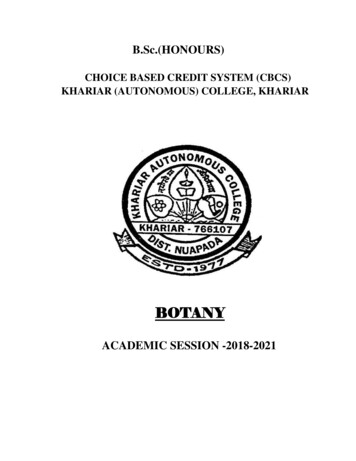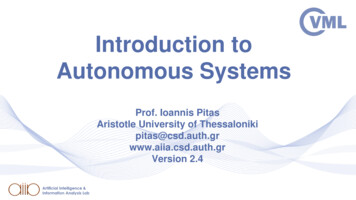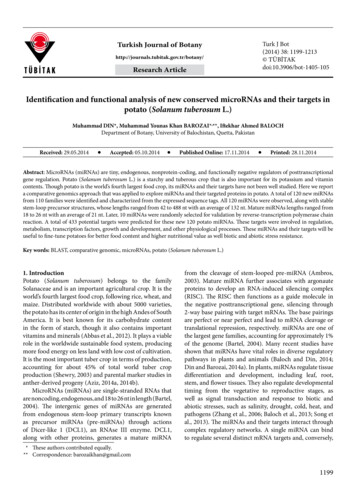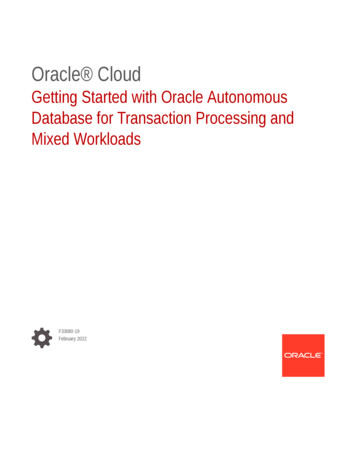
Transcription
B.Sc.(HONOURS)CHOICE BASED CREDIT SYSTEM (CBCS)KHARIAR (AUTONOMOUS) COLLEGE, KHARIARBOTANYACADEMIC SESSION -2018-2021
Semester-I-Core- IMicrobiology and Phycology – 100 marks(Credits-6: Theory-4, Practical-2)[75 marks (Mid Sem 15 End Sem 60)]Lectures: 60 [40 Theory 20 Practical classes](Unit-I will be examined for Mid-Term only and from Unit-II to Unit V for Term End Exam.)Introduction to microbial world, microbial nutrition, growth and metabolism. 2 icalcharacteristics; 5 lecturesclassification (Baltimore), general structure with special reference to viroidsand prions; replication (general account), DNA virus (T-phage), lytic andlysogenic cycle; RNA virus (TMV). Economic importance of viruses withreference to vaccine production, role in research, medicine.Unit-I.Unit–IIUnit-IIIUnit-IVBacteria: - Discovery, general characteristics, types-archaebacteria,5 lectureseubacteria, cell structure,nutritional types, reproduction-vegetative, asexual and recombination(conjugation, transformation and transduction). Economic importance ofbacteria with reference to their role in agriculture and industry (fermentationand medicine).Algae:- General characteristics;; range of thallus6 lecturesorganization; methods of reproduction, classification; criteria, system ofFritsch, significant,contributions of important phycologists (F.E. Fritsch, G.M. Smith,M.O.P. Iyengar). Role of algae in the environment, agriculture, biotechnologyand industry.Cyanophyta:- Ecology and occurrence,cellstructure, economic importance; role in biotechnology.Morphology and life-cycle of Nostoc.Chlorophyta:- General characteristics, occurrence, range of thallusorganization, cell structure Morphology and life-cycles ofChlamydomonas, Volvox, Oedogonium,Unit-VCharophyta:- General characteristics; occurrence, morphology, cellstructure and life-cycle of Chara; evolutionary significance.Xanthophyta:- General characteristicsOccurrence, morphology and life-cycle of Vaucheria.Phaeophyta:- Characteristics, occurrence, cellstructure Morphology and life-cycles of FucusRhodophyta:- General characteristics, occurrence,cell structure Morphology and life-cycle of Polysiphonia.5 lectures5 lectures2 lectures2 lectures2 lectures4 lectures
Practical (20 classes, each class of 2h)Microbiology 1. Electron micrographs/Models of viruses – T-Phage and TMV, Line drawings/Photographs of Lytic and Lysogenic Cycle.Types of Bacteria to be observed from temporary/permanent slides/photographs. Electronmicrographs of bacteria, binary fission, endospore, conjugation, root Nodule.Gram staining.Endospore staining with malachite green using the (endospores taken from soil bacteria).PhycologyStudy of vegetative and reproductive structures of Nostoc, Chlamydomonas(electron micrographs), Volvox, Oedogonium,Coleochaete, Chara, Vaucheria,Ectocarpus, Fucus and Polysiphonia,Procholoron through electron micrographs,temporary preparations and permanent slides.Suggested Readings1. Lee, R.E. (2008). Phycology, Cambridge University Press, Cambridge. 4th edition.2. Prescott, L.M., Harley J.P., Klein D. A. (2005). Microbiology, McGraw Hill, India. 6th edition.3. Kumar, H.D. (1999). Introductory Phycology. Affiliated East-West Press, Delhi.4. Sahoo, D. (2000). Farming the ocean: seaweeds cultivation and utilization. Aravali International, NewDelhi.5. Campbell, N.A., Reece J.B., Urry L.A., Cain M.L., Wasserman S.A. Minorsky P.V., Jackson R.B. (2008).Biology, Pearson Benjamin Cummings, USA. 8th edition.6. Pelczar, M.J. (2001) Microbiology, 5th edition, Tata McGraw-Hill Co, New Delhi.
Semester-ICore - II:Biomolecules and Cell Biology100 marks (Credits-6: Theory-4, Practical-2)THEORY (Each class 1 hour): PRACTICAL (Each class 2 hours)[75 marks (Mid Sem 15 End Sem 60)]Lectures: 60 [40 Theory 20 Practical classes](Unit-I will be examined for Mid-Term only and from Unit-II to Unit V for Term End Exam.)Unit-IBiomolecules:- Types and significance of chemical bonds; Structure andproperties of water; pH and buffers.Carbohydrates: Nomenclature and classification; Role of monosaccharides(glucose, fructose)Disaccharides:(sucrose, maltose, lactose), Oligosaccharides and polysaccharides(structural-cellulose, storage – starch, )2 lecturesLipids: Definition and major classes of storage and structural lipids. Storagelipids. Fatty acids structure and functions.Proteins: Structure of amino acids; Levels of proteinstructure-primary, secondary, tertiary and quarternary;biological roles of proteins.2 lectures3 lectures2 lectures2 lecturesUnit-IIUnit-IIIUnit-IVUnit-VTypes of nucleic acids; Structure of B-DNA;Types of RNA; Structure of tRNA.Bioenergenetics: Laws of thermodynamics, concept of free energy,endergonic and exergonic reactions, coupled reactions, redox reactions.ATP: structure, its role as a energy currency molecule.Enzymes: Structure of enzyme: holoenzyme, apoenzyme, cofactors,coenzymes and prosthetic group; Classification of enzymes; Features ofactive site, substrate specificity, mechanism of action (activation energy,lock and key hypothesis, induced - fit theroy), Michaelis – Menten equation,enzyme inhibition and factors affecting enzyme activity.The cell: Cell as a unit of structure and function; Characteristics ofprokaryotic and eukaryotic cells; Origin of eukaryotic cell (Endosymbiotictheory).Cell wall and plasma membrane:Chemistry, structure and function of Plant Cell Wall. Overview ofmembrane function; fluid mosaic model; Chemical composition ofmembranes; endocytosis and exocytosis.3 lectures4 lectures2 lectures3 lecturesCell organelles: Nucleus; Structure-nuclear envelope, nuclear porecomplex, nuclear lamina, molecular organization of chromatin; nucleolus.3 lecturesChloroplast, mitochondria and peroxisomes: Structural organization;Function; Semiautonomous nature of mitochondria and chloroplast.Endoplasmic Reticulum, Golgi Apparatus, LysosomesCell division: Eukaryotic cell cycle, different stages of mitosis and meiosis.Cell cycle, Regulation of cell cycle.2 lectures2 lectures6 lectures
Practical (20 classes, each class of 2h)Practical1. Qualitative tests for carbohydrates, reducing sugars, non-reducing sugars, lipids andproteins.2. Study of plant cell structure with the help of epidermal peel mount of Onion/Rhoeo3. Demonstration of the phenomenon of protoplasmic streaming in Hydrilla leaf.4. Measurement of cell size by the technique of micrometry.5. Study of cell and its organelles with the help of electron micrographs.6. Study the phenomenon of plasmolysis and deplasmolysis.7. Study different stages of mitosis and meiosis using aceto carmine and aceto orcinemethod.Suggested Readings1. Campbell, MK (2012) Biochemistry, 7th ed., Published by Cengage Learning2. Campbell, PN and Smith AD (2011) Biochemistry Illustrated, 4th ed., Published by ChurchillLivingstone.3. Tymoczko JL, Berg JM and Stryer L (2012) Biochemistry: A short course, 2nd ed., W.H.Freeman4. Berg JM, Tymoczko JL and Stryer L (2011) Biochemistry, W.H.Freeman and Company5. Nelson DL and Cox MM (2008) Lehninger Principles of Biochemistry, 5th Edition., W.H. Freemanand Company.6. Karp, G. (2010). Cell Biology, John Wiley & Sons, U.S.A. 6th edition.7. Hardin, J., Becker, G., Skliensmith, L.J. (2012). Becker‟s World of the Cell, Pearson Education Inc.U.S.A. 8th edition.8. Cooper, G.M. and Hausman, R.E. 2009 The Cell: A Molecular Approach. 5th edition. ASM Press &Sunderland, Washington, D.C.; Sinauer Associates, MA.th9. Becker, W.M., Kleinsmith, L.J., Hardin. J. and Bertoni, G. P. 2009 The World of the Cell. 7 edition.Pearson Benjamin Cummings Publishing, San Francisco
Semester-IICore -IIIMycology and Phytopathology –100 marks (Credits-6: Theory-4, Practical-2)THEORY (Each class 1 hour): PRACTICAL (Each class 2hours) [75 marks (Mid Sem 15 End Sem 60)]Lectures: 60 [40 Theory 20 Practical classes](Unit-I will be examined for Mid-Term only and from Unit-II to Unit V for Term End Exam.)Unit-IUnit-IIIntroduction to true fungi: Definition, General characteristics; Affinitieswith plants and animals; Thallus organization; Cellwall composition;Nutrition; Classification.5 lecturesZygomycota: General characteristics; Ecology; Thallus organisation; Lifecycle with reference to Rhizopus.Ascomycota: General characteristics (asexual and sexual fruiting bodies);Ecology; Life cycle, life cycle andclassification with reference to Aspergillus, Penicillium,Alternaria and Neurospora,Basidiomycota: General characteristics; Ecology; Life cycle andClassification with reference to black stem rust on wheat Puccinia(Physiological Specialization)4 lecturesAgaricus; Bioluminescence, Fairy Rings and Mushroom Cultivation.Oomycota: General characteristic; Ecology; Life cycle and classificationwith reference to Phytophthora, Albugo.Unit-IIIUnit-IVUnit-V5 lectures5 lectures4 lecturesSymbiotic associations: Lichen – Occurrence; General characteristics;Growth forms and range of thallus organization; Nature of associations ofalgal and fungal partners; iza and their significance.Applied Mycology: Role of fungi in biotechnology, Application of fungi infood industry (Flavour & texture, Fermentation, Baking, Organic acids,Enzymes, Mycoproteins); Secondary metabolites (Pharmaceuticalpreparations); Agriculture (Biofertilizers); Biological control,Medical mycology.4 lecturesPhytopathology: Terms and concepts; General symptoms;etiology; symptomology; Host- Pathogenrelationships;disease cycle and environmental relation; prevention andcontrol of plant diseases,. Bacterial diseases – Citruscanker and angular leaf spot disease of Cotton.Viral diseases – TobaccoMosaic viruses, vein clearing. Fungal diseases – Early blight of potato,white rust of crucifers.5 lectures5 LecturesPractical (20 classes, each class of 2h)Practical 1. Introduction to the world of fungi (Unicellular, coenocytic/septate mycelium, asocarps &basidiocarps).2. Rhizopus: study of asexual stage from temporary mounts and sexual structures throughpermanent slides.3. Aspergillus and Penicillium: study of asexual stage from temporary mounts. Study ofSexual stage from permanent slides/photographs.
4. Peziza: sectioning through ascocarp.5. Alternaria: Specimens/photographs and temporary mounts.6. Puccinia: Herbarium specimens of Black Stem Rust of Wheat and infectedBarberryleaves; sections/ mounts of spores on wheat and permanent slides of boththe hosts.7. Agaricus: Specimens of button stage and full grown mushroom; sectioning of gills ofAgaricus, fairy rings and bioluminescent mushrooms to be shown.8. Albugo: Study of symptoms of plants infected with Albugo; asexual phase studythroughsection/ temporary mounts and sexual structures through permanent slides.9. Lichens: Study of growth forms of lichens (crustose, foliose and fruticose) on differentsubstrates. Study of thallus and reproductive structures (soredia and apothecium)through permanent slides. Mycorrhizae: ectomycorrhiza and endo mycorrhiza(Photographs)10. Phytopathology: Herbarium specimens of bacterial diseases; Citrus Canker; Viraldiseases: TMV, Fungal diseases: Early blight of potato, and White rust of crucifers.Suggested Readings1. Agrios, G.N. 1997 Plant Pathology, 4th edition, Academic Press, U.K.2. Alexopoulos, C.J., Mims, C.W., Blackwell, M. (1996). Introductory Mycology, John Wiley & Sons(Asia) Singapore. 4th edition.3. Webster, J. and Weber, R. (2007). Introduction to Fungi, Cambridge University Press, Cambridge. 3rdedition.4. Sethi, I.K. and Walia, S.K. (2011). Text book of Fungi and Their Allies, Macmillan Publishers IndiaLtd.5. Sharma, P.D. (2011). Plant Pathology, Rastogi Publication, Meerut, India.
Semester-IICore – IVArchegoniate100 marks (Credits-6: Theory-4, Practical-2)[75 marks (Mid Sem 15 End Sem 60)]Lectures: 60 [40 Theory 20 Practical classes](Unit-I will be examined for Mid-Term only and from Unit-II to Unit V for Term End Exam.)Unit-IIntroduction: Unifying features of archegoniates; Transition to land habit;Alternation of generations.Bryophytes: General characteristics; Adaptations to land habit;Classification; Range of thallus organization.Classification (up to6 lecturesfamily).Riccia, Marchantia,Unit-IIUnit-IIIUnit-IVUnit-VHigher Bryophyte: Porella, Anthoceros, Sphagnum andReproduction and evolutionary trends in Riccia, Marchantia ,Anthoceros (developmental stages not included). Ecological andeconomic importance of bryophytes with special reference toSphagnum.Pteridophytes: General characteristics, classification. Classification (up tofamily), morphology, anatomy and reproduction of Psilotum, Selaginella,Equisetum (Developmental details not to be included).Apogamy,and apospory, heterospory andseed habit, telome theory,Ecological and economic importance.Gymnosperms: General characteristics, classification (up to family),morphology, anatomy and reproduction of Cycas, Pinus, andGnetum. (Developmental details not to be included). Ecological andeconomic importance.Fossils: Geographical time scale, fossils and fossilization process.Morphology, anatomy and affinities of Rhynia, Calamites,Lyginopteris .6 lectures10 lectures8 lectures)8 lecturesPractical (20 classes, each class of 2h)Practical1. Riccia – Morphology of thallus.2. Marchantia- Morphology of thallus, whole mount of rhizoids & Scales, vertical sectionofthallus through Gemma cup, whole mount of Gemmae (all temporary slides), verticalsection of Antheridiophore, Archegoniophore, longitudinal section of Sporophyte(all permanent slides).3. Anthoceros- Morphology of thallus, dissection of sporophyte (to show stomata,spores,pseudoelaters, columella) (temporary slide), vertical section of thallus (permanentslide).4. Pellia, Porella- Permanent slides.5. Sphagnum- Morphology of plant, whole mount of leaf (permanent slide only).6. Funaria- Morphology, whole mount of leaf, rhizoids, operculum, peristome,annulus,spores (temporary slides); permanent slides showing antheridial andarchegonial heads, longitudinal section of capsule and protonema.7. Psilotum- Study of specimen, transverse section of synangium (permanent slide).8. Selaginella- Morphology, whole mount of leaf with ligule, transverse section ofstem,whole mount of strobilus, whole mount of microsporophyll andmegasporophyll (temporary slides), longitudinal section of strobilus (permanentslide).9. Equisetum- Morphology, transverse section of internode, longitudinal section ofstrobilus,transverse section of strobilus, whole mount of sporangiophore, whole mount ofspores (wet and dry) (temporary slide), transverse section of rhizome (permanent
slide).10. Pteris- Morphology, transverse section of rachis, vertical section of sporophyll,wholemount of sporangium, whole mount of spores (temporary slides), transversesection of rhizome, whole mount of prothallus with sex organs and youngsporophyte (permanent slide).11. Cycas- Morphology (coralloid roots, bulbil, leaf), whole mount ofmicrosporophyll,transverse section of coralloid root, transverse section of rachis,vertical section of leaflet, vertical section of microsporophyll, whole mount of spores(temporary slides), longitudinal section of ovule, transverse section of root(permanent slide).12. Pinus- Morphology (long and dwarf shoots, whole mount of dwarf shoot, maleandfemalecones), transverse section of Needle, transverse section of stem,longitudinal section of transverse section of male cone, whole mount ofmicrosporophyll, whole mount of Microspores (temporary slides), longitudinalsection of female cone, tangential longitudinal section & radial longitudinal sectionsstem (permanent slide).13. Gnetum- Morphology (stem, male & female cones), transverse section of stem,verticalsection of ovule (permanent slide)14. Botanical excursion.Suggested Readings1. Vashistha, P.C., Sinha, A.K., Kumar, A. (2010). Pteridophyta. S. Chand. Delhi, India.2. Bhatnagar, S.P. & Moitra, A. (1996). Gymnosperms. New Age International (P) Ltd Publishers, NewDelhi, India.3. Parihar, N.S. (1991). An introduction to Embryophyta: Vol. I. Bryophyta. Central Book Depot.Allahabad.4. Raven, P.H., Johnson, G.B., Losos, J.B., Singer, S.R. (2005). Biology. Tata McGraw Hill, Delhi.5. Vander-Poorteri 2009 Introduction to Bryophytes. COP.
Semester-IIICore –VAnatomy of Angiosperms –100 marks (Credits-6: Theory-4, Practical-2)THEORY (Each class 1 hour): PRACTICAL (Each class 2hours) [75 marks (Mid Sem 15 End Sem 60)]Lectures: 60 [40 Theory 20 Practical classes](Unit-I will be examined for Mid-Term only and from Unit-II to Unit V for Term End Exam.)Unit-IUnit-IIIntroduction and scope of Plant Anatomy: Applications in systematics,2 lecturesTissues: Classification of tissues; Simple and complex tissues (nophylogeny); tracheary elements and sieveelements; Wall ingrowths and transfer cells,5 LecturesStem: Organization of shoot apex (Apical cell theory, Histogen theory,Tunica Corpus theory, cytohistologicalzonation); Types of vascular bundles; Structure of dicot and monocot stem.Root: Organization of root apex (Apical cell theory, Histogen theory,5 Lectures4 LecturesKorper-Kappe theory); Quiescentcentre; Root cap; Structure of dicot andmonocot root; Endodermis, exodermis and origin oflateral root.Unit-IIIUnit –IVVascular Cambium: Structure, function and seasonal activity of cambium;Secondary growth in root and stem.Wood: Types of rays and axialparenchyma; Sapwood and heartwood;Ring and diffuse porous wood; Early and late wood,tyloses;4 LecturesPeriderm: Development and composition of periderm, andlenticels.Adaptive and Protective Systems Epidermal tissue system, cuticle,epicuticular waxes, trichomes(uni-and multicellular, glandular andnonglandular, two examples of each), stomata (classification);Anatomical adaptations of xerophytes and hydrophytes.Secretory System: Hydathodes, cavities, lithocysts and laticifers.3 Lectures5 Lectures5 Lectures3 Lectures4 LecturesUnit - VLeaf: Structure of dicot and monocot leaf, Kranz anatomyPractical (20 classes, each class of 2h)Practical 1. Study of anatomical details through permanent slides/temporary stain mounts/macerations/museum specimens with the help of suitable examples.2. Apical meristem of root, shoot and vascular cambium.3. Distribution and types of parenchyma, collenchyma and sclerenchyma.4. Xylem: Tracheary elements-tracheids, vessel elements; thickenings; perforation plates;xylem fibres.5. Wood: ring porous; diffuse porous; tyloses; heart- and sapwood.6. Phloem: Sieve tubes-sieve plates; companion cells; phloem fibres.7. Epidermal system: cell types, stomata types; trichomes: non-glandular and glandular.8. Root: monocot, dicot, secondary growth.9. Stem: monocot, dicot - primary and secondary growth; periderm; lenticels.10. Leaf: isobilateral, dorsiventral, C4 leaves (Kranz anatomy).11. Adaptive Anatomy: xerophytes, hydrophytes.12. Secretory tissues: cavities, lithocysts and laticifers.
Suggested Readings1. Dickison, W.C. (2000). Integrative Plant Anatomy. Harcourt Academic Press, USA.2. Fahn, A. (1974). Plant Anatomy. Pergmon Press, USA.3. Mauseth, J.D. (1988). Plant Anatomy. The Benjammin/Cummings Publisher, USA.4. Esau, K. (1977). Anatomy of Seed Plants. John Wiley & Sons, Inc., Delhi
Semester-IIICore - VIEconomic Botany – 100 marks(Credits-6: Theory-4, Practical-2)THEORY (Each class 1 hour): PRACTICAL (Each class 2 hours)[75 marks (Mid Sem 15 End Sem 60)]Lectures: 60 [40 Theory 20 Practical classes](Unit-I will be examined for Mid-Term only and from Unit-II to Unit V for Term End rigin of Cultivated Plants: Concept of Centres of Origin, Vavilovs work,their importanceExamples of major plant introductions;Crop domestication and loss of genetic diversity; evolution of newcrops/varieties.Cereals : Wheat and Rice (origin, morphology, processing & uses), briefaccount of millets.Legumes: General account, importance to man and ecosystem.Sugars & Starches: Morphology and processing of sugarcane,Potato – morphology, propagation & uses.3 lectures3 lectures3 lectures2 lecturesSpices:Listing of important spices, economicimportance with specialreference to fennel, saffron, clove and black pepperBeverages: Tea, Coffee (morphology, processing & uses)Drug-yielding plants: Therapeutic and habit-forming drugs with specialreference to Cinchona, Papaver .Tobacco: Tobacco (Morphology, processing, uses and health hazards)Oils & Fats: General description, classification, extraction, their uses andgroundnut, coconut, linseed and Brassica and Coconut(Botanical name, family & uses)Essential Oils: General account, extraction methods,2lecturesNatural Rubber: Para-rubber: tapping, processing and uses.Timber plants: General account with special reference to teak and pine.Fibres: Cotton and Jute(Morphology, extraction and uses).2 lectures2 Lectures2 lectures4 lectures2 lectures2 lectures4 lectures2 lecturesPractical (20 classes, each class of 2h)1. Cereals: Rice (habit sketch, study of paddy and grain, starch grains, micro-chemical tests).2. Legumes: Soya bean, Groundnut, (habit, fruit, seed structure, micro-chemical tests).3. Sugars & Starches: Sugarcane ( habit sketch; cane juice- micro-chemical tests),Potato(habit sketch, tuber morphology, T.S. tuber to show localization of starchgrains, w.m. starch grains, micro-chemical tests).4. Spices: Black pepper, Fennel and Clove (habit and sections).5. Beverages: Tea (plant specimen, tea leaves), Coffee (plant specimen, beans).6. Oils & Fats: Coconut- T.S. nut, Mustard–plant specimen, seeds; tests for fats incrushedseeds.7. Essential oil-yielding plants: Habit sketch ofRosa, Vetiveria, Santalum and Eucalyptus(specimens/photographs).8. Rubber: specimen, photograph/model of tapping, samples of rubber products.9. Drug-yielding plants: Specimens of Digitalis, PapaverandCannabis.10. Tobacco: specimen and products of Tobacco.11. Woods: Tectona, Pinus: Specimen, Section of young stem.12. Fibre-yielding plants: Cotton (specimen, whole mount of seed to show lint andfuzz;whole mount of fibre and test for cellulose), Jute (specimen, transverse sectionof stem, test for lignin on transverse section of stem and fibre).
Suggested Readings1. Kochhar, S.L. (2012). Economic Botany in Tropics, MacMillan & Co. New Delhi, India.2. Wickens, G.E. (2001). Economic Botany: Principles & Practices. Kluwer Academic Publishers,The Netherlands.3. Chrispeels, M.J. and Sadava, D.E. (2003). Plants, Genes and Agriculture. Jones & Bartlett Publishers.
Semester-IIICore -VIIGenetics100 marks (Credits-6: Theory-4, Practical-2)THEORY (Each class 1 hour): PRACTICAL (Each class 2 hours)[75 marks (Mid Sem 15 End Sem 60)]Lectures: 60 [40 Theory 20 Practical classes](Unit-I will be examined for Mid-Term only and from Unit-II to Unit V for Term End Exam.)Unit-IUnit-IIUnit-IIIUnit-IVUnit-VMendelian genetics and its extension Mendelism: History; Principles ofinheritance; Chromosome theory of inheritance; Autosomes and sexchromosomes; Probability and pedigree analysis; Incomplete dominance andcodominance; Multiple alleles, Lethal alleles, Epistasis, Pleiotropy,Recessive and Dominant traits, Penetrance and Expressivity, Numericals;Polygenic inheritance.Extrachromosomal Inheritance: Chloroplast mutation: Variegation in Fouro‟clock plant; Mitochondrial mutations in yeast.Linkage, crossing over and chromosome mapping: Linkage and crossingover-Cytological basis of crossing over; Recombination frequency, twofactor and three factor crosses; Interference and coincidence; Numericalsbased on gene mapping; Sex Linkage.Variation in chromosome number and structure: Deletion, Duplication,Inversion, Translocation,Euploidy and AneuploidyGene mutations: Types of mutations; Molecular basis of Mutations;Mutagens – physical and chemicalDetection of mutations: DNA repair mechanisms.16 lecturesFine structure of gene: Classical vs molecular concepts of gene; Cis-Transcomplementation test for functional allelism; Structure of Phage T4,6 lecturesPopulation and Evolutionary Genetics: Allele frequencies, Genotypefrequencies, Hardy-Weinberg Law, role of natural selection,mutation, genetic drift. Genetic variation and Speciation.6 lectures6 lectures12 lectures8 lectures6 lecturesPractical (20 classes, each class of 2h)Practical1. Meiosis through temporary squash preparation.2. Mendel‟s laws through seed ratios. Laboratory exercises in probability and chi-squareanalysis.3. Chromosome mapping using test cross data.4. Pedigree analysis for dominant and recessive autosomal and sex linked traits with floralchart.5. Incomplete dominance and gene interaction through seed ratios (9:7, 9:6:1, 13:3, 15:1,12:3:1, 9:3:4).6. Blood Typing: ABO groups & Rh factor.7. Study of aneuploidy: Down‟s, Klinefelter‟s and Turner‟s syndromes.8. Photographs/Permanent Slides showing Translocation Ring, Laggards and InversionBridge.
Suggested Readings1. Gardner, E.J., Simmons, M.J., Snustad, D.P. (1991). Principles of Genetics, John Wiley & sons, India.8th edition.2. Snustad, D.P. and Simmons, M.J. (2010). Principles of Genetics, John Wiley & Sons Inc., India. 5thedition.3. Klug, W.S., Cummings, M.R., Spencer, C.A. (2012). Concepts of Genetics. Benjamin Cummings,U.S.A. 10th edition.4. Griffiths, A.J.F., Wessler, S.R., Carroll, S.B., Doebley, J. (2010). Introduction to Genetic Analysis. W.H. Freeman and Co., U.S.A. 10th edition.
Semester-IVCore -VIIIMolecular Biology –100 marks (Credits-6: Theory-4, Practical-2)THEORY (Each class 1 hour): PRACTICAL (Each class 2 hours)[75 marks (Mid Sem 15 End Sem 60)]Lectures: 60 [40 Theory 20 Practical classes](Unit-I will be examined for Mid-Term only and from Unit-II to Unit V for Term End ucleic acids : Carriers of genetic information: Historical perspective;DNA as the carrier of genetic information (Griffith‟s, Hershey & Chase,Avery, McLeod & McCarty, Fraenkel -Conrat‟s experiment.The Structures of DNA and RNA / Genetic Material: DNA Structure:Watson and Crick- historic perspective, DNA structure, Salientfeatures of double helix, Types of DNA, Types of genetic material,RNA Structure- Organelle DNA mitochondria and chloroplast DNA.The Nucleosome -Chromatin structureEuchromatin,Heterochromatin-4 lecturesThe replication of DNA:General principles – bidirectional, semi-conservative and semidiscontinuous replication, replicationof linear ds-DNA, replication of the 5‟end of linear chromosome; Enzymesinvolved in DNA replication.Central dogma and genetic code: -TheCentral Dogma (Adaptor hypothesis and discovery of mRNAtemplate),Genetic code (deciphering & salient features)Mechanism of Transcription: Transcription in prokaryotes; Transcriptionin eukaryotesProcessing and modification of RNA: Split genes-concept of introns andexons, removal of introns,alternative splicing eukaryotic mRNAprocessing(5‟ cap, 3‟ polyA tail); Ribozymes, RNA editingand mRNA transport.Translation (Prokaryotes and eukaryotes): Ribosome structure andassembly, mRNA; Charging of tRNA, aminoacyl tRNA synthetases; Varioussteps in protein synthesis, proteins involved in initiation, elongation andtermination of polypeptides,Post -translational modifications of proteins.Regulation of transcription in prokaryotes and eukaryotes: Principles oftranscriptional regulation; Prokaryotes: Regulation of lactose metabolismand tryptophan synthesis in E.coli. Eukaryotes: transcription factors,6 lectures8 lectures2 lectures4 lectures5 lectures6 lectures5 lecturesPractical (20 classes, each class of 2h)1. Preparation of LB medium and raising E.Coli.2. Isolation of genomic DNA from E.Coli.3. DNA isolation and RNA estimation by orcinol method.4. DNA estimation by diphenylamine reagent/UV Spectrophotometry.5. Study of DNA replication mechanisms through photographs (Rolling circle, Thetareplication and semi-discontinuous replication).6. Study of structures of prokaryotic RNA polymerase and eukaryotic RNA polymerase II
through photographs.7. Photographs establishing nucleic acid as genetic material (Messelson and Stahl‟s, Avery etal, Griffith‟s, Hershey & Chase‟s and Fraenkel & Conrat‟s experiments)8. Study of the following through photographs: Assembly of Spliceosome machinery; Splicingmechanism in group I & group II introns; Ribozyme and Alternative splicing.Suggested Readings1. Watson J.D., Baker, T.A., Bell, S.P., Gann, A., Levine, M., Losick, R. (2007). Molecular Biology of theGene, Pearson Benjamin Cummings, CSHL Press, New York, U.S.A. 6th edition.2. Snustad, D.P. and Simmons, M.J. (2010). Principles of Genetics. John Wiley and Sons Inc., U.S.A. 5thedition.3. Klug, W.S., Cummings, M.R., Spencer, C.A. (2009). Concepts of Genetics. Benjamin Cummings. U.S.A.9th edition.rd4. Russell, P. J. (2010). iGenetics- A Molecular Approach. Benjamin Cummings, U.S.A. 3 edition.5. Griffiths, A.J.F., Wessler, S.R., Carroll, S.B., Doebley, J. (2010). Introduction to Genetic Analysis. W. H.Freeman and Co., U.S.A. 10th edition.
Semester-IVSkill Enhancement Courses-II(Credits-2: Lectures: 30 )THEORY (Each class 1 hour)50 marks (Mid Sem 10 End Sem 40)ETHNOBOTANY(Unit-I will be examined for Mid-Term only and from Unit-II & Unit III for Term End Exam.)Unit-1Introduction, Concept, scope and objective: EthnobotanyEthnobotany as an interdisciplinary science. The relevance of Ethnobotany in the present context,Major and minor ethnic groups.Plants used by tribals: a) Food plants b) Intoxicants and bevarages.Unit-2Methodology of Ethnobotanical studiesa) Field workb) Herbariumc) Ancient literatured) Temple and scared placesEthnobotony as a tool to protect interests of ethnic groupUnit-3Role of Ethnobotany in Modern MedicineMedico- Ethnobotanical sources in India. Significance of the following plants in ethno botanicalpractices( along with their habitat and morphology)a) Azadirachta indicab) Vitex negundob) Ocimum sanctumd) Gloriosa superb e) Cassia auriculata.Role of Ethnobotany in modern medicine with special example Rauvolfia serpentine, Trichopus
Unit-I Introduction to microbial world, microbial nutrition, growth and metabolism. 2 lectures Viruses:- Discovery,physiochemical and biological characteristics; 5 lectures classification (Baltimore), general structure with special reference to viroids










